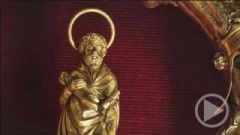The Beginnings of Venice
It all begins with the fall of the Roman empire, and the Romans on the run. In the year 395 the gigantic Empire was divided . The new capital city in the East, on an equal footing with Rome, was Constantinople, formerly Byzantium. The Eastern Roman Empire would exist for more than a thousand years. It was also later described as the “Byzantine Empire”.
As for the old centre of imperial power, it was being overrun by Barbarians: Goths, Huns and Lombards. People fled in panic from the cities out to the lagoon. They felt safe in the labyrinth of sludgy creeks and more than one hundred islands. Eventually, they founded a city. Its centre became a small island called “high bank”, or “rivo alto” – later “Rialto”.
Gradually, the whole of northern Italy was conquered by the Franks. But not Veneto; around the lagoon an eastern Roman province persisted. The former refugees maintained this western outpost of the Byzantine Empire. As true Romans, they knew how best to utilise their relations with the East and the unique location of their city: they improved construction of their ships and imported goods from the Orient to central Europe. This marked the start of an incredible success story – that transformed Malaria-infested refugee camps into the richest and most powerful trade metropolis in Europe.
The patron saint of the young city was St. Theodore, a brother of St. George. But then the Venetians decided they wanted a more potent patron, one that would do justice to their burgeoning self-confidence. And they were to receive just that - by way of an audacious theft. The story has been immortalized several times in St. Mark’s Basilica.
In the year 828, several Venetian sea traders were gathered in Alexandria. Their captains Buono da Malamocco and Rustico da Torcello had some dramatic news to report: The tomb of St. Mark was in danger! At the time, Alexandria had been governed for more than 100 years by Muslims, who now seemed intent on destroying all Christian houses of worship. Buono and Rustico had heard this in the burial church of St. Mark itself, from priest Theodoros and a monk named Staurazio.
The Venetians applied gentle pressure on the two clergymen to bring the saint’s remains to safety – in faraway Venice. They developed a strategy to smuggle the precious relic past Arab customs officials – and concealed the remains beneath a cargo of pork. Muslims view this as impure, and indeed, the guards allowed the dubious goods to pass through the checkpoint without inspection.
The tradesmen and the saint’s remains were given an enthusiastic reception in Venice. The abduction was indeed an ingenious coup: relics were highly revered in the Middle Ages. This is evident from the collection of more than 100 valuable reliquaries in the treasury of St. Mark’s.


